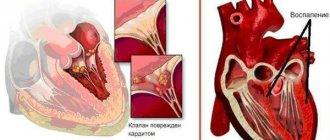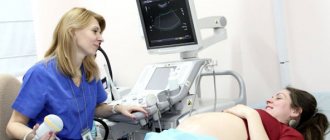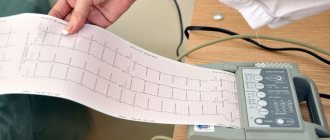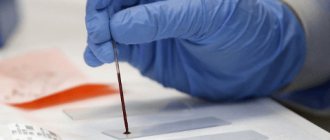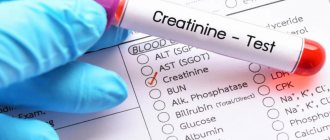So-called rheumatism or acute rheumatic fever (according to new terminology) is a systemic inflammatory disease of connective tissue, in which the pathological process has a tropism towards the membranes of the heart and joints.
Even at the beginning of the 20th century, the concept of “rheumatism” meant almost any disease of the joints - doctors did not have the need or opportunity to differentiate these ailments, especially since the range of healing procedures was not diverse. Today, a rheumatologist has a wide range of diagnostic methods in his arsenal, allowing him to distinguish rheumatism from many other rheumatological diseases, each of which has its own treatment strategy.
Rheumatism is a disease predominantly of children aged 6 to 15 years, and only 1 child in 1000 suffers in this age group.
Primary rheumatism in adult patients is observed less frequently. According to statistics, women are 2-3 times more likely to suffer from this disease than men.
Rheumatism usually begins some time after a streptococcal infection of the nasopharynx, and after a few years it can turn into a chronic, incurable disease. Fortunately, only 1-3% of patients who have an infection become victims of rheumatic fever.
1
Consultation with a rheumatologist
2 Consultation with a rheumatologist
3 Consultation with a rheumatologist
Causes of rheumatism
Why do some people get rheumatism, while others under the same conditions do not? People who often suffer from ENT diseases are more likely to get rheumatism. Those at risk are those whose relatives have this disease and those who have the B-cell marker D8/17 in their blood.
So, the risk factors:
- streptococcal infection (angina, scarlet fever, pharyngitis);
- defects of the immune system, the presence of autoimmunity;
- genetic predisposition to the disease.
How to treat?
Since the disease is systemic in nature, treatment of rheumatism is carried out under the strict supervision of medical specialists. As a rule, complex therapy is used, the main goals of which are to suppress infection, stop the inflammatory process and prevent or treat cardiovascular pathologies. The therapy consists of three stages.
- Hospital treatment. It includes drug therapy - taking non-steroidal anti-inflammatory drugs, antibiotic therapy, and other prescriptions depending on the symptoms. If necessary, to eliminate the source of chronic infection, tonsils can be removed, but not earlier than 2-3 months after the onset of the disease. In addition, the patient is prescribed nutritional therapy and exercise therapy. Special diets for rheumatism involve split meals (at least 5-6 meals a day), a high protein content and a minimum of carbohydrates, fresh and processed vegetables. Protein foods are mainly fish, eggs and dairy products.
- Cardio-rheumatic sanatorium. The therapy started in the hospital continues, dosed physical activity, walks, hardening and restorative physical procedures, and dietary nutrition are added to it.
- Dispensary observation. At this stage, the goal of treatment efforts is preventive measures to prevent relapses and stop the process.
Timely detection and adequate therapy, as a rule, lead to complete recovery of patients.
Clinical picture of rheumatism
The trigger for the development of rheumatism is the entry of streptococcus into the body, as a result of which the immune system begins to produce antibodies to fight the infection. However, in the body itself, namely in connective tissues and heart muscle, there are molecules of the same structure. Due to the presence of this factor, the immune system begins to “fight” its cells. As a result, connective tissue is damaged, and this is fraught with heart defects and joint deformation.
Forms of rheumatism
- cardiac form (cardiac rheumatism), when all the membranes of the heart are affected (pancarditis), myocardium (myocarditis), endocardium (endocarditis);
- articular form (rheumatism of the joints);
- cutaneous form;
- pulmonary form (pleurisy);
- rheumatic chorea (St. Vitus' dance).
Forecast
The prognosis for this disease is made taking into account the nature of the disease and the degree of myocardial damage.
The frequency of observation by a cardiologist depends on:
- phases of the disease
- attack frequency
- severity of attacks
- associated septic condition
- circulatory failure.
An unfavorable prognosis is observed in young patients with associated septic process, when death is possible. Deaths are observed in patients due to acute coronary circulatory disorders.
Don't risk your health! Timely contact with a qualified doctor and the adoption of emergency measures, as well as competent organization of the regime in the active phase of the disease, can prevent the development of irreversible heart damage and improve the prognosis.
Symptoms of rheumatism
Rheumatism has a wide variety of manifestations: damage to the heart, joints, nervous and respiratory systems. 2-3 weeks after contracting a sore throat or pharyngitis, the first signs of rheumatism appear: fever, weakness, fatigue, headache. In some people, acute rheumatism begins 1-2 days after hypothermia, even without connection with infection.
Rheumatism of the heart
Already at the beginning of the disease, pain in the heart begins, increased heartbeat, shortness of breath even at rest.
Rheumatic arthritis
With articular rheumatism of the legs and arms, pain appears in the knee, elbow, wrist, and shoulder joints. The joints swell, active movements in them are limited. As a rule, after taking non-steroidal anti-inflammatory drugs, pain from rheumatism quickly disappears.
Skin rheumatism
With cutaneous rheumatism, vascular permeability increases. Therefore, skin rashes appear on the lower extremities.
Rheumatic pleurisy
A fairly rare manifestation of the disease. Main symptoms: body temperature remains above 38 degrees, severe pain in the chest, dry cough, shortness of breath, pleural noise can be heard on auscultation. More often the disease is limited to a fairly mild form of pleurisy.
1 ECG
2 Echocardiography with Doppler analysis
3 X-ray examination
Rheumatic manifestations of damage to the nervous system
Sometimes rheumatism can provoke damage to the meninges, subcortex and medulla. One of the manifestations of the disease is the dance of St. Vitus. With this complication, convulsive, involuntary contraction of the muscles of the face, torso of the arms and legs occurs. With a sharp contraction of the glottis, suffocation can occur, which is very dangerous for human life.
Abdominal syndrome
This type of complication is typical for children and adolescents. Accompanied by elevated body temperature, nausea, vomiting, and abdominal pain in the form of contractions.
Rheumatism should not be left to chance or treated by relying on the advice of friends and relatives, even those familiar with this disease. Loss of time leads to progression of the disease and dangerous complications in rheumatism. There is a threat of developing atrial fibrillation and myocardiosclerosis. Possible damage to the lungs and kidneys. And the most dangerous thing is thromboembolism (blockage of the pulmonary artery by a blood clot), which can suddenly end the patient’s life.
RHEUMATISM IN CHILDREN: old and new.
Lecture for doctors
Many modern pediatricians and even pediatric rheumatologists regard the problem of rheumatism in children as one of the sections of the history of medicine, or, at least, as a problem that is losing its relevance. And this is not surprising if we remember that once upon a time there were massive outbreaks and even epidemics of rheumatism in the Soviet Union and throughout the world. Already in the 30s and 40s, the hospital mortality rate of children from rheumatism, mainly from an active process involving the myocardium, was up to 40%. The incidence of heart defects reached 50–75%. Every fifth or sixth child developed combined heart defects. All this forced doctors and medical theorists to join forces. This time was marked by a number of fundamental changes both in medical science and in the organization of medical care. Various treatment regimens for sore throats and pharyngitis, dosages and timing of administration of salicylates and aspirin were tested. The first specialized service in the world and the second in the USSR appeared - the rheumatology service and its independent division - the country's children's rheumatology service. Its birth can be dated back to 1932, when the All-Union Rheumatic Committee created its own children's section. In the management of all departments of the rheumatological service, much attention was paid not only to the management of the disease itself and measures for its timely recognition, but also its social basis and the importance of social prevention measures were emphasized in every possible way. Already in the 30s, when almost 30 years remained before the widespread recognition of the streptococcal etiology of rheumatism, the children's section of the All-Union Rheumatic Committee developed the following recommendations: “Prior to obtaining more definite conclusions regarding the etiology and taking into account the doctrine of rheumatism at the present stage, one should proceed from the idea of rheumatism in children and adolescents as a long-term process of an infectious nature, affecting mainly the cardiovascular system with transient episodic manifestations mainly in the form of polyarthritis and chorea" (collection dedicated to the 50th anniversary of the work of A. A. Kisel, published in Moscow in 1934). Only in the 60s was it possible to confirm and clarify the role of streptococcus as a specific pathogen or etiological factor of rheumatism, and moreover, specifically β-hemolytic streptococcus group A (BHSGA). And today we can say that among a wide range of rheumatic diseases, rheumatism is the first disease for which an exogenous etiological factor has become known.
The instructiveness of the history of the fight against rheumatism lies, first of all, in the fact that even with a far from complete understanding of the essence and etiology of the disease, practically on the basis of clinical and epidemiological data alone, it became possible to significantly improve the diagnosis and treatment of this disease. All this, together with a number of organizational measures, turned out to be sufficient for the prevalence of the disease to begin to decline. In the 60–70s in the country (USSR), the overall incidence of rheumatism was 20–30 cases per 1000, and this figure varied significantly depending on the region. So, in 1968 in Moscow and Leningrad it amounted to eight to nine cases per 1000 people, in Ufa - 38, and in Krasnoyarsk - 98 cases. Mortality among hospitalized patients dropped to 2%, and heart defects developed in 15–30% of children with rheumatism. Further efforts to prevent the spread and chronicity of infections caused by group A β-hemolytic streptococcus and the introduction of strict rules for antibacterial therapy for sore throats and pharyngitis led to a decrease in incidence. The incidence figures in our country turned out to be comparable to those in developed countries (about 0.3–0.8 per 1000). At the same time, it was not possible to achieve complete elimination of both rheumatogenous streptococcus itself and rheumatism in any country in the world. Moreover, in all countries there are “outbreaks” of group diseases, especially when children, adolescents or young people live in limited common areas (tents in camps, barracks, dormitories). And the decrease in practical experience in recognizing rheumatism among modern pediatricians determines the high probability of diagnostic errors and, as a consequence, late recognition of the disease. Finally, achievements in the fundamental disciplines of medicine regularly reveal new aspects of the pathogenetic relationships between rheumatogenous infection and organ damage, that is, they expand the very concept of rheumatism and its clinical manifestations. Some of the new “discoveries” related to the problem of rheumatism make it possible to significantly expand the field of activity of clinicians, while the idea of the “clinical image of the disease” and its infectious-allergic essence does not undergo fundamental changes. Therefore, even today the value of clinical observations, which are reflected in the works of the classics of pediatric rheumatology - A. A. Kisel (1939, 1940), A. B. Volovik (1939, 1940, 1955), L. D. Steinberg (1957), Z I. Edelman (1962), A. V. Dolgopolova (1963, 1965, 1977), does not decrease in any way. Moreover, their recommendations are simply irreplaceable for training doctors who rarely encounter cases of the development of various forms of rheumatism, and are thus doomed to a second and very long life.
Rheumatism occupies a very unique position among other pathologies. Primarily, it is an infection caused by group A β-hemolytic streptococcus (BHSHA). The most significant strains in the epidemiology of rheumatism are M-types 1.3. 5.6. 14. 18.19.27 and 29. The authors of many modern pediatric manuals have moved the chapters on rheumatism to the sections on infections. And one can hardly object to this. GABHS can occur as a common and highly virulent infection, causing both purulent inflammatory processes and generalized toxic shock-like syndromes. In recent years, there has been an increase in the incidence of such infections and syndromes. The list of diseases includes: streptococcal respiratory tract infections, tonsillitis, pharyngitis, their complications - cervical lymphadenitis, peritonsillar and retropharyngeal abscesses, sinusitis, mastoiditis, otitis media, pneumonia, skin diseases, both superficial pyoderma (impetigo) and deep lesions. Strains of the microbe that secrete proteinases can cause widespread necrotizing processes in the skin, subcutaneous tissue (cellulitis), as well as fasciitis and myositis. Vulvitis-vaginitis in prepubertal girls and perianal dermatitis and proctitis in children of both sexes are described as characteristic lesions for streptococcus. Generalization of streptococcal infection with symptoms of meningitis, sepsis or bacterial myocarditis is also not uncommon. But the greatest threat to the patient’s life is shock-like toxic syndrome. Its clinical and laboratory criteria are given below.
Streptococcal toxic shock-like syndrome (STSS) criteria:
- disseminated intravascular coagulation;
- kidney damage;
- liver damage;
- respiratory distress - adult-type syndrome;
- scarlet-like rash;
- necrotic changes in soft tissues.
But even as a rheumatogenous infection, BGSGA stands apart from other infections. It differs in epidemiology: it rarely occurs in children who are most susceptible to most other infections - newborns and young children. Outbreaks of the disease are observed only in those groups where streptococcus (BHSGA) is able to attach itself quite firmly to the cells of the mucous membrane of the pharynx and cause a rather long inflammatory process (usually at least nine to ten days). Children aged 4–5 to 15–18 years are most often affected. However, not all children and adolescents in this age group develop the disease. Already after the first observations of the relationship between the pathogen and the disease, a family grouping of cases of rheumatism was identified, that is, we are talking about the existence of “rheumatic diathesis” or a predisposition to rheumatism in 1-3% of children and adults who suffered tonsillitis and pharyngitis caused by GABHS.
It is possible that this predisposition may be associated with certain markers in histocompatibility antigens, both positive (predisposition) and negative (protection). We present one of the tables in which such associations are presented (data from different authors) below (see Table No. 1).
Among other markers of specific predisposition, in recent years, particular attention has been drawn to B-lymphocyte membrane molecules detected using monoclonal antibodies or specific alloantigens, designated as D8/17. In rheumatism, they are detected in almost 100% of studies, while in control groups - in 6–15% of cases (Khanna OK et al. 1989).
The variety of influences of a microbe on the cells, tissues and functions of the affected organism is determined to a large extent by the many virulence factors secreted by this pathogen. These include the factors presented in Table 2.
And finally, the most specific point in the pathogenesis of rheumatism is associated with the property of cross-reactivity, that is, the cross-reaction of antibodies directed at the components and factors of streptococcus with antigens of the tissue structures of the macroorganism. Examples are shown in Table 3.
The given list of antigenic mimicry and cross-reactions is far from complete; one can assume the presence of many and very complex interactions between streptococcal antigens and cells of the immune system. In addition, the presence of a positive feedback has been shown between the activation of CD4+ lymphocytes (helpers) and the increase in the production of IL-1( and IL-2), which, in turn, increases the production of CD4+ and the accumulation of pro-inflammatory interleukins. It has been shown that this system of autogeneration of inflammatory activity is closely correlates with tissue inflammatory lesions and, above all, with carditis.
The cause of systemic inflammatory activity in the vascular bridgehead can also be circulating immune complexes of varying composition and degree of complexity. Thus, in the work of L.I. Monogarova (1985), the different pathogenetic significance of immune complexes with streptococcal and cardiac antigens was shown. Often, tissue and humoral indicators of the inflammatory activity of rheumatism are determined by the presence of concomitant and independent chains of pathogenesis, also of a constitutional, genetically determined nature, for example, antiphospholipid syndrome. In the presence of the latter, the course of rheumatism always turns out to be more malignant, and the damage to the heart is more significant and manifests itself mainly in the form of endomyocarditis with evolution into valvular heart defects.
It can be argued that in addition to the constitutionality of the very occurrence of rheumatism in response to infection, which has already been discussed above, each patient also has a constitutionality in the activity of inflammatory manifestations, which is relatively stable for the entire course of the disease and its relapses. This was shown in the work of V.V. Yuryev (1980).
In the clinical picture of the disease, especially during its first attacks, the presence of a certain “latent” period between the experience of tonsillitis or pharyngitis and the subsequent onset of fever, weakness, intoxication and pallor of the skin is determined. At the same time, the main clinical syndromes of rheumatism develop: arthritis, carditis, chorea, erythema annulare, rheumatic nodules.
Arthritis is present in the vast majority of cases of onset of the disease. More often it is polyarthritis, quite symmetrical, affecting mainly large joints and at the same time migrating. A high degree of pain in the joints is characteristic, not only during movement, but also during complete rest, often due to pronounced hyperesthesia of the skin over the joints. Rheumatoid arthritis is always benign and does not lead to destructive changes in the joints or joint disability. It is also characterized by relatively high sensitivity to non-steroidal anti-inflammatory drugs. In rare cases, arthritis takes a protracted course - up to eight to ten weeks.
Carditis undoubtedly remains the main and most severe manifestation of the disease. Acute carditis with circulatory failure used to pose an immediate threat to life, but today rheumatic valvulitis and the formation of heart defects are of greatest importance for the prognosis. Recognizing carditis in the active phase is not difficult, especially when using modern ultrasound equipment. Early periods of valvulitis of the mitral or aortic valves are characterized by the appearance of very quiet and gentle noises during auscultation (“blowing” timbre as described by Prof. A. B. Volovik). The timing of its appearance is the third or fourth week from the onset of a rheumatic attack. Rheumatic endocarditis can recur in the future and aggravate heart pathology even at low degrees of process activity.
Erythema annulare is extremely specific for GABHS infection and it is no coincidence that it is included among the main diagnostic criteria, although it is not observed very often (in 5–15% of all cases). Erythema confirms the presence of vasculitis and a high probability of carditis. Pink, irregularly shaped and completely flat half-rings of rashes with a pale central part and without itching are located on the torso, abdomen and inner surfaces of the arms and thighs.
Rheumatic nodules used to be extremely rare, but in the last five to ten years they have become more common among other clinical signs. Mono- and polyserositis, regular nosebleeds, limited pneumonitis, and renal involvement, clinically determined by repeated episodes of hematuria, and observed in 25–60% of patients on kidney biopsy, are systematically noted as possible manifestations.
Of great interest is the emergence in recent years of a new clinical syndrome associated with GABHS and called PANDAS or “pediatric autoimmune neuropsychiatric disorders associated with streptococcal infection.” For convenience, we will further refer to them as ANNAS - autoimmune neuropsychiatric disorders associated with streptococcus. Clinical manifestations can be variable, they are often in the nature of obsessive-compulsive disorders, but are combined with such nonspecific disorders as motor hyperactivity, impulsivity, absent-mindedness, emotional lability, age-inappropriate behavior, attention disorders, difficulty falling asleep, tics and obsessive movements, syndrome Tourette's, sometimes anorexia. The closeness or even close relationship of this syndrome with rheumatism and especially chorea is confirmed by the presence in ANNAS of a similar association with GABHS infection and the same frequency of detection of D8/17 lymphocyte alloantigens. All approaches to prevention and treatment adopted for rheumatism are effective in the treatment of ANNAS. Thus, it is obvious that previously approved provisions regarding the clinical manifestations and forms of rheumatism in children must be revised and supplemented.
The diagnosis of rheumatism is usually made in accordance with the modified Jones criteria.
Diagnostic problems
First of all, it should be noted that the criteria for diagnosing the disease, last revised in 1992, are applicable only to primary rheumatism. Relapses are recognized by the clinical picture of the disease and the activity of markers of inflammatory activity, but a chronological connection and significant increases in markers of streptococcal infection are not necessary. Finally, there is a rule: the presence of a clinical picture of carditis or chorea in the absence of other etiological factors can be considered (and treated) as probable rheumatism. There are no strict distinctions between rheumatism and post-streptococcal reactive arthritis. In our opinion, post-streptococcal arthritis, with its proven connection with GABHS, should be classified as rheumatism without obvious (at the moment) heart damage. According to our experience and literature data, 10–40% of such children may subsequently experience relapses involving the heart, so it is advisable to carry out the full range of preventive measures considered mandatory for patients with rheumatism.
The main practical problem of diagnosis verification, and especially acute for post-streptococcal arthritis, is associated with the need for strict typing of streptococcus. Arthritis after infection with streptococci of groups C and G is not related to rheumatism, since it does not cause either concomitant or remote myocardial damage and chorea.
Thus, rheumatologists need to agree on the classification of forms of rheumatism in children. The time has come to include in the classification such a variant or form as PANDAS or ANNAS. In addition, clinicians often pay insufficient attention to the form, which is represented in most cases only by erythema annulare with a confirmed connection with GABHS infection and inflammatory activity. At the same time, increased levels of circulating immune complexes and changes in coagulation tests are observed. In fact, we are talking about a form or phase of rheumatism with dominance of rheumatic vasculitis and with a very high probability of the addition of carditis, which, however, does not develop in all cases.
Treatment of rheumatism in children
In the first place in the treatment of rheumatism is the need to eliminate the bacterial pathogen. This can be done quickly only with the help of effective antibacterial therapy - a single intramuscular injection of penicillin G. An alternative for hemorrhagic manifestations is the administration of penicillin V orally at a dose of 500 or 250 mg per day, dividing the dose into four doses. If you are allergic to penicillin, you can use antibiotics from the macrolide group - erythromycin at a dose of 40 mg/kg per day, or a new antibiotic of this group - azithromycin.
Anti-inflammatory non-steroidal drugs should be prescribed for at least three weeks.
In the presence of carditis, it is customary to prescribe glucocorticoids at a dose of 1-2 mg/kg body weight (up to 60 mg per day) for a period of 10 to 15 days, followed by a dose reduction of 20-25% each subsequent week of therapy. Salicylates are not necessary when treating with hormones, but should be included when leaving hormones.
Glucocorticoids have no effect in the treatment of chorea. Treatment with haloperidol is recommended at a dose of 0.5 to 1.0 mg per day, increasing the dose by 0.5 mg every three days of treatment (the dose should not exceed 5 mg per day). Sodium valproate (15–20 mg/kg per day) has been shown to be effective. In the most resistant cases, intravenous immunoglobulins, plasmapheresis sessions, reserpine, and perphenazine are used.
The table on secondary prevention does not indicate the timing of its implementation, since each individual case requires an individual approach. However, it should be noted that you have to choose mainly between five or ten years or prescribing antibiotics for life.
I. M. Vorontsov, Doctor of Medical Sciences, Professor
PMA, St. Petersburg
Diagnosis of rheumatism
General condition
Confirmation of current or recent group A β-hemolytic streptococcal infection based on culture or serologic data (antigen or antibody titers)
Jones criteria
| Major clinical criteria | Minor clinical criteria |
|
|
Diagnostic rule
- Rheumatism is highly probable: under the general condition + two major + one minor criterion.
- Rheumatism is possible: under general conditions + one major + two minor criteria.
Notes to the general condition - a statement of the relationship of clinical manifestations with a current or recent GABHS infection.
- A positive throat culture is not a reliable sign, since the child may be a carrier of GHSGA, which is not related to the present disease.
- Increasing or elevated titers of antistreptolysin-O or antideoxyribonuclease B are sufficient to confirm a current or recent infection, taking into account the following factors:
- the increase in ASO titers continues for three to six weeks after the infection;
- the increase in anti-DNAse-B titers continues for six to eight weeks;
- some strains of GHSGA give an isolated increase in only one category of antibodies;
- early active antibiotic therapy can significantly limit the expected increase in antibody titers.
Diagnosis of rheumatism
When diagnosing the disease, the following methods are used:
- ECG;
- Ultrasound of the heart;
- X-ray examination (helps to see changes in the size and shape of the heart);
- general blood test (can show ESR level, anemia, etc.);
- immunological blood test (appearance of C-reactive protein, presence of streptococcal infection).
1 General blood test
2 Immunological blood test
3 Diagnostics of rheumatism in MedicCity
How to recognize the disease
The external signs of rheumatism are varied, and the course of the disease can be acute, subacute, protracted or recurrent. Symptoms depend on the nature of the process and which organs are affected by inflammation. A typical clinical picture appears in the second or third week after a streptococcal infection. The patient's temperature rises, weakness, increased sweating, and headaches develop. At an early stage, arthralgia is possible - painful sensations in large or medium-sized joints. They are present in almost all patients.
After two to three weeks, to the listed symptoms of rheumatism, signs indicating damage to the heart tissue are added. Various manifestations in the form of pain localized in the heart area, rapid heartbeat, and shortness of breath are recorded in 70-80% of patients. The disease affects all the membranes of the heart or some of them. Most often, the inflammatory process involves the tissues of the myocardium and endocardium, less often with the involvement of the pericardium.
Almost all patients experience asthenic syndrome, including fatigue, lethargy, and a feeling of malaise.
In approximately 10% of patients in the most acute phase of the disease, an annular rash appears on the skin - ring-shaped pink rashes that do not protrude above the surface. Very rarely, the inflammatory process affects other organs - lungs, kidneys, liver, etc. This mainly happens in the most severe form of the disease.
Are you experiencing symptoms of rheumatism?
Only a doctor can accurately diagnose the disease. Don't delay your consultation - call
